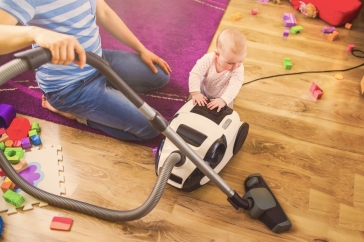Taking action to avoid harmful chemical exposures at home and beyond
By Robin Dodson, ScD
 Last year, we published a study in which we identified the top 10 consumer product chemicals you’re most likely exposed to through house dust. These include phthalates, a class of hormone-disrupting chemicals used in plastics, phenols found in cleaning products, flame retardants in furniture, a fragrance compound, and non-stick chemicals called PFASs (per- and polyfluorinated alkyl substances) used in cookware and stain-resistant carpets.
Last year, we published a study in which we identified the top 10 consumer product chemicals you’re most likely exposed to through house dust. These include phthalates, a class of hormone-disrupting chemicals used in plastics, phenols found in cleaning products, flame retardants in furniture, a fragrance compound, and non-stick chemicals called PFASs (per- and polyfluorinated alkyl substances) used in cookware and stain-resistant carpets.
The study, done in collaboration with our colleagues at the Milken Institute of Public Health at George Washington University and the Natural Resources Defense Council (NRDC), marked the first comprehensive analysis of toxic chemicals in U.S. household dust, revealing what the average American is exposed to on a routine basis. What’s concerning is that these chemicals have been associated with serious health effects including cancer, hormone disruption, and developmental and reproductive problems. They migrate out of products, settle in dust, and enter your body through ingestion or inhalation. Young children are especially vulnerable because they crawl around on the floor and frequently put their hands in their mouths.
The evidence linking environmental exposures with health problems is significant enough that major medical and scientific associations have begun sounding the alarms. What’s more, the economic impacts are not trivial. According to a recent study, daily exposure to low levels of hormone-disrupting chemicals such as phthalates and flame retardants cost the United States more than $340 billion a year from health care costs and lost earning.
Over the years, scientists have devoted significant time and energy toward understanding the risks posed by these environmental chemicals—where they come from, how they get into your body, and what effects they have on your health. It’s time now for us to devote resources toward preventing these unwanted exposures, so we can prevent future health problems. In a recent commentary in the Journal of Epidemiology and Community Health, my colleagues and I describe what actions people can take to reduce their exposures at home—strategies that can be applied to workplaces and schools as well. For example, look for products with safer ingredients—things like fragrance-free cleaning products or non-vinyl flooring that doesn’t contain phthalates.
There are many consumer guides and mobile apps out there to help you make these kinds of healthier choices, but they have their limits: Safer alternatives often cost more than conventional products, many of the guides rely on product ingredient labels that are not always accurate, and companies often are not required to disclose chemicals of concern in their products, leaving consumers like you feeling powerless to make informed choices.
The good news is there are other things you can do that are effective at reducing exposures and don’t rely on buying particular products. For instance, consider simple changes to your daily routine:
- Wash your hands frequently, especially before mealtime, and make sure your kids wash their hands too!
- Use a damp cloth to wipe down surfaces
- Clean your floors regularly with a wet mop
- Vacuum with a high-efficiency particulate absorber (HEPA) filter
- Increase ventilation throughout your home
Silent Spring has a mobile app called Detox Me that incorporates behavioral changes and more into a comprehensive approach to healthier living. Given that we spend 90 percent of our time indoors, small changes in our personal habits can make a real difference!
And it’s important to note that the burden does not rest entirely on you the consumer to protect yourself and your family from toxic chemicals in products. Advocacy campaigns and new legislation that target chemicals are critical. Take the Consumer Product and Safety Improvement Act. Passed in 2008, it prohibits the use of certain phthalates in toys and childcare products. Right after the legislation passed, national biomonitoring data showed levels of these chemicals in people’s bodies already had begun to drop. Unfortunately, levels of a substitute phthalate with similar toxicity started going up, highlighting the need to regulate classes of chemicals as opposed to one chemical at a time.
Governments can also require better disclosure of chemicals of concern in products. States including California, Washington, Vermont, and Maine have all passed disclosure laws for certain kinds of products, and we hope other states will follow suit. At the federal level, the recent Toxic Substances Control Act (TSCA), if properly implemented, could go a long way toward protecting the public, in particular vulnerable populations such as low-income and minority communities, from harmful everyday chemicals.
In other words, there’s a lot you can do at home to keep harmful chemicals at bay, but long-term solutions for protecting the greater public from toxics require action at multiple levels and on multiple fronts. From individuals, to communities, to advocacy organizations, to governments—all these groups combined can help put us on a path toward a healthier environment, and one that will sustain us for generations to come.

Robin Dodson, ScD, is a Research Scientist at Silent Spring Institute specializing in chemical exposures and risk assessment, particularly in the indoor environment.
Resources or References
Bennett D et al. 2016. Project TENDR: Targeting Environmental Neuro-Developmental Risks The TENDR Consensus Statement. Environ Health Perspect, 124 (7): A118-22
Di Renzo GC et al. 2015. International Federation of Gynecology and Obstetrics opinion on reproductive health impacts of exposure to toxic environmental chemicals. International Journal of Gynecology & Obstetrics, 131(3): 219-25.
Attina TM et al. 2016. Exposure to endocrine-disrupting chemicals in the USA: a population-based disease burden and cost analysis. The Lancet Diabetes & Endocrinology, 4(12): 996-1003
Consumer Product Safety Improvement Act of 2008. US Code Title 15, Chapter 47, Section 2051, Public Law 110-314.
Zota AR et al. 2014. Temporal trends in phthalate exposures: Findings from the National Health and Nutrition Examination Survey, 2001-2010. Environ Health Perspect, 122(3): 235-41.